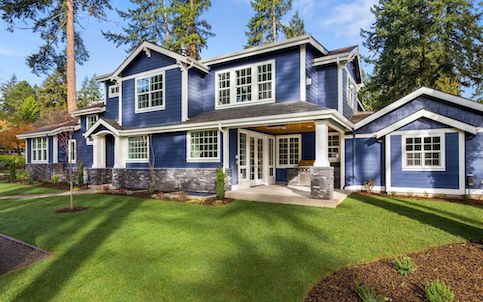

The hard truth of buying a house is that when you spend less in one category, you often end up spending more in another to make up for it. If you buy a cheaper home, you might spend more on maintenance and repairs. If you try to save on closing costs by rolling them into your loan, you end up with higher monthly payments.
If you get a Federal Housing Administration (FHA) mortgage so you can afford a low down payment, you’ll have to pay a mortgage insurance premium (MIP). But what’s a mortgage insurance premium and does it differ from regular mortgage insurance?
Let’s take a look at what MIPs are, how they work and how to calculate how much you’ll be paying.
Mortgage insurance helps offset the lender’s risk when a borrower makes a small down payment; as low down payments increase the amount of money your lender loses if you default on your mortgage (lower down payment = larger loan).
Since FHA mortgages allow for down payments as low as 3.5% for borrowers with a credit score as low as 580, mortgage insurance is required for all FHA home loans. The mortgage insurance you’ll pay on an FHA loan is simply referred to as a mortgage insurance premium, or MIP.
Please note that it is possible to get an FHA loan with a credit score as low as 500, but you’ll need to put 10% down and could end up with a higher annual percentage rate (APR). Be advised that most lenders won’t offer the loan if your median score is below 580.
All FHA mortgage borrowers – with one exception – will pay 1.75% of the loan amount in upfront mortgage insurance premium (UFMIP). While UFMIP is due at closing, this one-time cost can be financed, meaning the UFMIP can be included in the loan amount, and the borrower won’t have to bring this cash to the closing table.
Borrowers will also have their annual premiums added to their monthly mortgage payments. Annual premiums can range between 0.15 – 0.75% of the loan amount, depending on how much is borrowed, how much is put down and how long the loan term is.
You can get a real, customizable mortgage solution based on your unique financial situation.
The exception to this is borrowers who are doing an FHA Streamline Refinance on an FHA loan that was endorsed prior to June 1, 2009. These borrowers will pay UFMIP that’s 0.01% of the loan amount. Additionally, their annual MIP will amount to 0.55% of the loan.
If you’re wondering if this exception applies to you, know that your endorsement date isn’t the same as your closing date. Endorsement typically happens shortly after closing. If you aren’t sure what your endorsement date is, you’ll need to contact the FHA.
If you aren’t in this group, how much you’ll pay for your annual mortgage insurance on your FHA loan will depend on a few different factors.
Your annual MIP will be divided evenly across each of your monthly mortgage payments.
Say, for example, you’re getting a 30-year FHA loan for $200,000, and you make a down payment of 3.5%. In this scenario, your annual MIP rate would end up being 0.85% of your loan amount, or $1,700 per year. That means that each month, about $142 of your mortgage payment will go toward this annual premium.
Now that you know what MIP is, it’s important to understand the difference between MIP and other types of mortgage insurance you might come across.
On a conventional mortgage, mortgage insurance is referred to as private mortgage insurance (PMI). Borrowers with a conventional mortgage will have to pay PMI only if they make a down payment less than 20%.
This differs from FHA loans, on which borrowers will pay mortgage insurance regardless of the size of their down payment. Both MIP and PMI insure the lender against risk in the event the borrower defaults on their type of loan.
MIP or PMI shouldn’t be confused with mortgage protection insurance (MPI). Out of these three types of insurance, MPI is the only policy that benefits the homeowner.
In the event of the borrower’s death, MPI will pay off the loan so that the remaining household members don’t have to worry about either taking over the mortgage or losing the house. Because of this, MPI is actually considered to be a type of life insurance.
MIP and PMI only benefit the lender, even though borrowers pay the premiums.
Let’s take a look at some commonly asked questions about MIP.
FHA loans are often seen as a good option for borrowers with less money saved up as these loans allow down payments as low as 3.5%. However, because of this, it’s impossible to avoid MIP on an FHA loan.
If you have enough cash saved up to make a 20% down payment, applying for a conventional mortgage might be a better option for you. When you make a 20% down payment on a conventional loan, you won’t have to pay for mortgage insurance.
Additionally, if you put less than 20% down on a conventional loan, you’ll be able to have PMI removed when you reach 20% equity in your home, which isn’t the case for MIP on FHA loans.
In some cases, you may be able to have MIP removed. However, many FHA borrowers will pay MIP for the life of their loans.
If you have at least 20% equity in your home but aren’t eligible to have MIP removed, your best option may be to refinance into a conventional loan – as long as that makes sense for your current financial situation. When you refinance into a conventional loan and keep at least 20% equity in your home, you won’t be required to pay for mortgage insurance.
Neither United States Department of Agriculture (USDA) nor Department of Veterans Affairs (VA) loans require mortgage insurance. However, because each mortgage does allow for a low – or even no – down payment, additional costs and fees are set in place to protect lenders from the risk of borrowers defaulting on their loans.
Though MIP can increase your monthly mortgage payments, it can also help make homeownership more accessible to those who can’t afford some of the high upfront costs that come with it.
If you’re considering an FHA loan, it’s important to weigh all the costs that’ll come with that loan. You may decide that MIP is worth being able to keep your down payment affordable, or you may prefer to wait and save your money so you can afford a mortgage insurance-free loan. It all depends on what makes the most sense for you.
Get approved to see what you qualify for.












LMB Mortgage Services, Inc., (dba Quicken Loans), is not acting as a lender or broker. The information provided by you to Quicken Loans is not an application for a mortgage loan, nor is it used to pre-qualify you with any lender. If you are contacted by a lender or broker advertising within our network, your quoted rate may be higher depending on your property location, credit score, loan-to-value ratio, debt-to-income ratio, and/or other factors. Quicken Loans does not offer its matching services in all states. This loan may not be available for all credit types, and not all service providers in the Quicken Loans network offer this or other products with interest-only options. The information that we provide is from companies which Quicken Loans and its partners may receive compensation. This compensation may influence the selection, appearance, and order of appearance on this site. The information provided by Quicken Loans does not include all financial services companies or all of their available product and service offerings. Article content appears via license from original author or content owner, including Rocket Mortgage.
Note: Actions on this website are recorded for quality assurance or training purposes. Input of data constitutes consent.
Quicken Loans is a registered trademark of Rocket Mortgage, LLC, used under license by LMB Mortgage Services, Inc.
LMB Mortgage Services, Inc. | NMLS #167283
4859 W Slauson Ave #405 Los Angeles, CA 90056